Chapter 12
1/27
There's no tags or description
Looks like no tags are added yet.
Name | Mastery | Learn | Test | Matching | Spaced |
|---|
No study sessions yet.
28 Terms
According to the Keynesian framework, __ in ______ may cause inflation, but not a recession.
a. a increase; consumer taxes
b. an increase; domestic investment
c. a decrease; a major trading partner's economy
d. a decrease; government spending
b. an increase; domestic investment
Keynesian economics focuses on explaining why recessions and depressions occur, as well as offering a for minimizing their effects.
a. pricing strategy
b. macro-economic model
c. set of menu costs
d. policy prescription
d. policy prescription
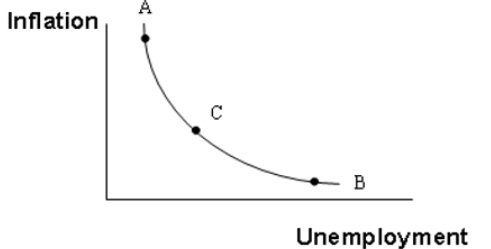
Refer to the graph shown below. Point C in the graph represents:
a. the level Keynesian macroeconomic policy strives for.
b. a moderate growth level in the economy.
c. a moderate level of unemployment in the economy.
d. moderate inflation and all of the above.
d. moderate inflation and all of the above.
If a Phillips curve shows that unemployment is high and inflation is low in the economy, then that economy:
a. is producing at its potential GDP.
b. is producing at a point where output is more than potential GDP.
c. is producing at a point where output is less than potential GDP.
d. is producing at its equilibrium point.
c. is producing at a point where output is less than potential GDP.
If a Phillip curve shows that unemployment is low and inflation is high in the economy, then that economy:
a. is producing at its potential GDP.
b. is producing at a point where output is more than potential GDP.
c. is producing at a point where output is less than potential GDP.
d. is producing at its equilibrium point.
b. is producing at a point where output is more than potential GDP.
The economy is in a recession and the government wants to increase output. If the multiplier equals 3 and the government increases spending by 250, how much will output increase by?
a. 50
b. 100
c. 200
d. 750
d. 750
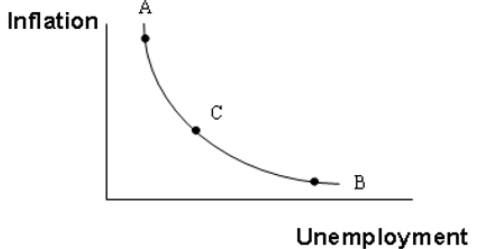
Refer to the graph shown below. At point A:
a. economic growth is declining.
b. the economy's unemployment rate is very low
c. inflation tends to be declining.
d. wages can be lowered due to worker surplus.
b. the economy's unemployment rate is very low
Which of the following is a distinguishing characteristic of a Keynesian cross diagram?
a. real GDP on the vertical axis
b. a horizontal line representing aggregate expenditure
c. 45-degree line
d. several different Phillips curves
c. 45-degree line
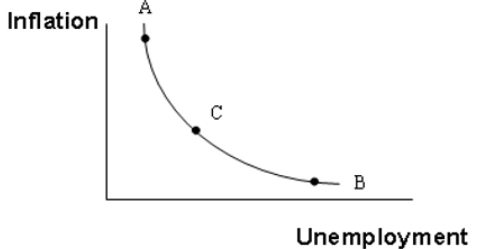
Refer to the graph shown below. This graph illustrates a:
a. Keneyesian Curve.
b. Neoclassical Curve.
c. Phillips Curve.
d. Labor Demand Curve.
c. Phillips Curve.
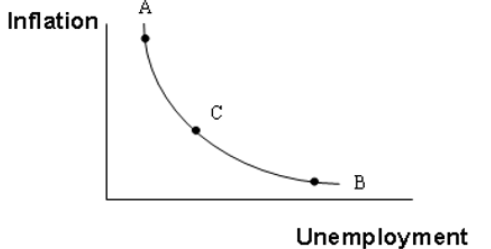
In a Keynesian cross diagram, what name is given to the distance between an output level that is above potential GDP and the level of potential GDP?
a. expenditure-output
b. inflationary gap
c. recessionary gap
d. national income (Y)
b. inflationary gap
The sum of all the income received for contributing resources to GDP is called _.
a. national income (Y)
b. national revenue (Y)
c. marginal income (X)
d. marginal revenue (X)
a. national income (Y)
Aggregate demand is more likely to _________________ than aggregate supply in the short run.
a. shift substantially
b. remain unchanged
c. decrease substantially
d. increase slightly
Consumption, investment, government spending, exports, and imports are:
a. all complementary elements of a market-orientated economy.
b. some of the opposing elements found in a market-orientated economy.
c. all components of aggregate demand.
d. some of the building blocks of Keynesian analysis.
Suppose that out of the original 100 increase in government spending, 60 will be recycled back into purchases of domestically produced goods and services. Following this multiplier effect, what value will be recycled in the next round in the cycle?
a. 42
b. 3.6
c. 16.66
d. 36
If markets throughout the global economy all have flexible and continually adjusting prices, then:
a. all market-oriented economies will implement coordinated wage reductions.
b. each economy will trends towards its natural rate of unemployment.
c. each economy must shift in aggregate demand and create additional employment.
d. all changes in prices and wages will create additional employment.
According to the Keynesian framework, which of the following may help a country reduce inflation, but will not help that country to get out of a recession?
a. increased spending by the government on health care
b. an increase in taxes on business investments
c. an increase in military spending
d. a decrease in the tax rate on consumer income
According to the Keynesian framework, _______________ will not help reduce inflation, but may help a country get out of a recession.
a. increased spending by the government on health care
b. increased taxes on business investments
c. decreased military spending
d. increased consumer tax rates
The equilibrium quantity of labor decreases and the equilibrium wage increases when:
a. labor supply shifts to the left, if wages are flexible. b. labor demand shifts to the left, if wages are flexible. c. labor demand shifts to the right, if wages are flexible.
d. labor supply shifts to the right, if wages are flexible,
In macroeconomics, a _________________ is used to show the relationship between inflation and unemployment in the short run.
a. Phillips curve
b. microeconomic model
c. expenditure-output model
d. Keynesian framework
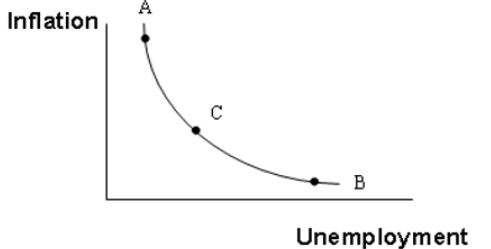
Refer to the graph shown below. At point B:
a. economic growth it low or even negative.
b. output is expanding.
c. unemployment is very low.
d. businesses may raise prices.
If a Keynesian expenditure-output model shows that aggregate demand for both goods and labor has shifted to the left while wages and prices are unchanged, what will be the result?
a. excess supply in the goods market and excess supply in the labor market
b. natural rate of unemployment
c. coordinated wage reductions
d. depression
According to the Keynesian framework, which of the following will not help a country to get out of a recession, but may help that country reduce inflation? a. an increase in military spending
b. a decrease in military spending
c. increase in spending by the government on health care
d. decrease in business taxes
In a Keynesian cross diagram, what name is given to the distance between an output level that is below potential GDP and the level of potential GDP?
a. expenditure-output
b. inflationary gap
c. recessionary gap
d. national income (Y)
According to the _____________________ argument, a market-oriented economy has no obvious way to implement a plan of systematic wage reductions.
a. sticky wage and price
b. sticky wage
c. Keynesian
d. coordination
The equilibrium quantity of labor and the equilibrium wage increase when:
a. labor supply shifts to the right, if wages are flexible. b. labor demand shifts to the right, if wages are flexible.
c. labor demand shifts to the left, if wages are flexible. d. labor supply shifts to the left, if wages are flexible.
The onset of a trade deficit is most likely supported by a country's:
a. existing trade surplus.
b. strong economic growth.
c. reduction in the balance of trade.
d. increased consumption function.
In macroeconomics, what name is given to the costs of changing prices that businesses must consider?
a. opportunity costs
b. internal costs
c. menu costs
d. customer costs
Keynesian economics focuses on explaining why recessions and depressions occur, as well as offering a ______________________ for minimizing their effects.
a. pricing strategy
b. macro-economic model
c. set of menu costs
d. policy prescription
d. policy prescription